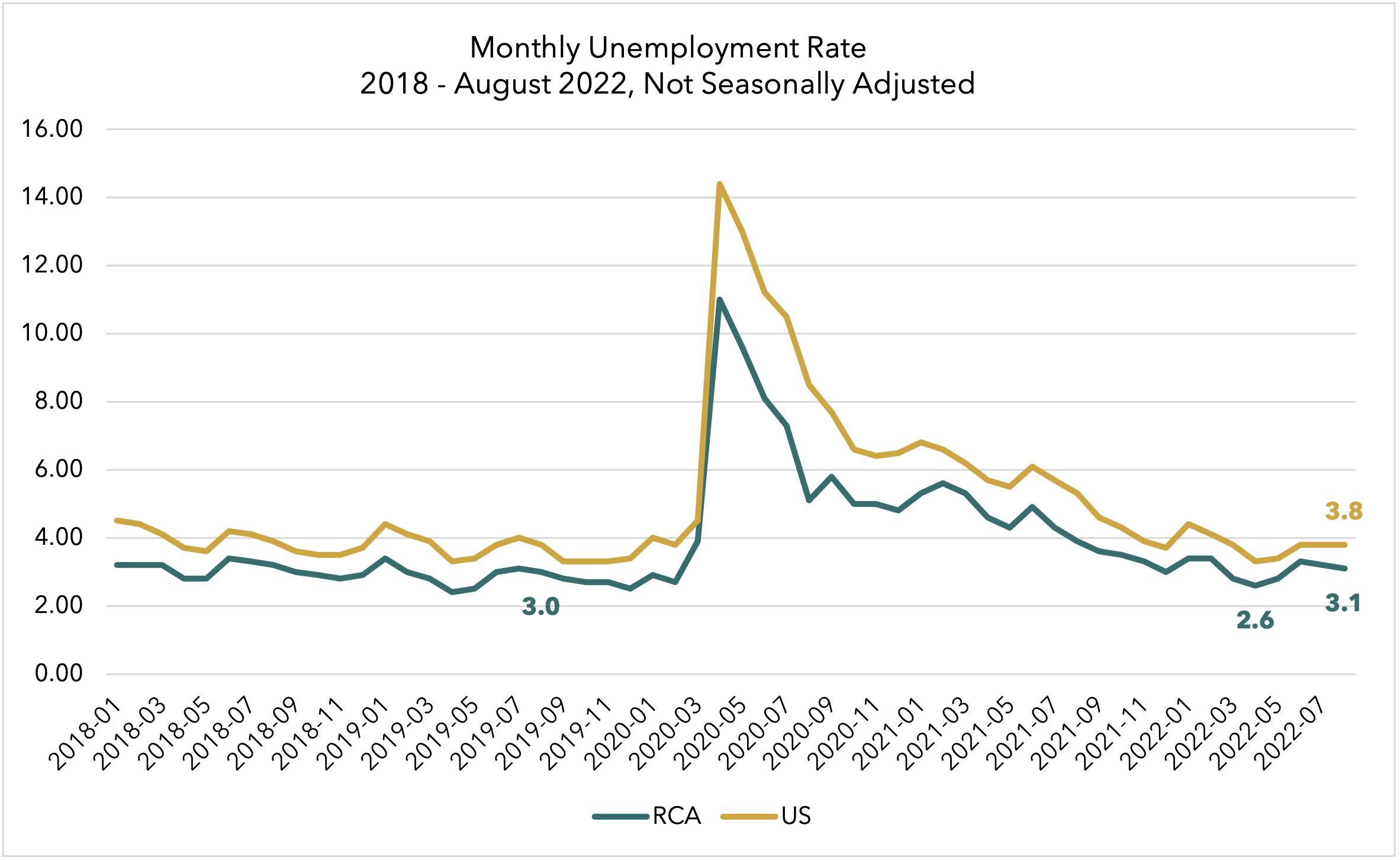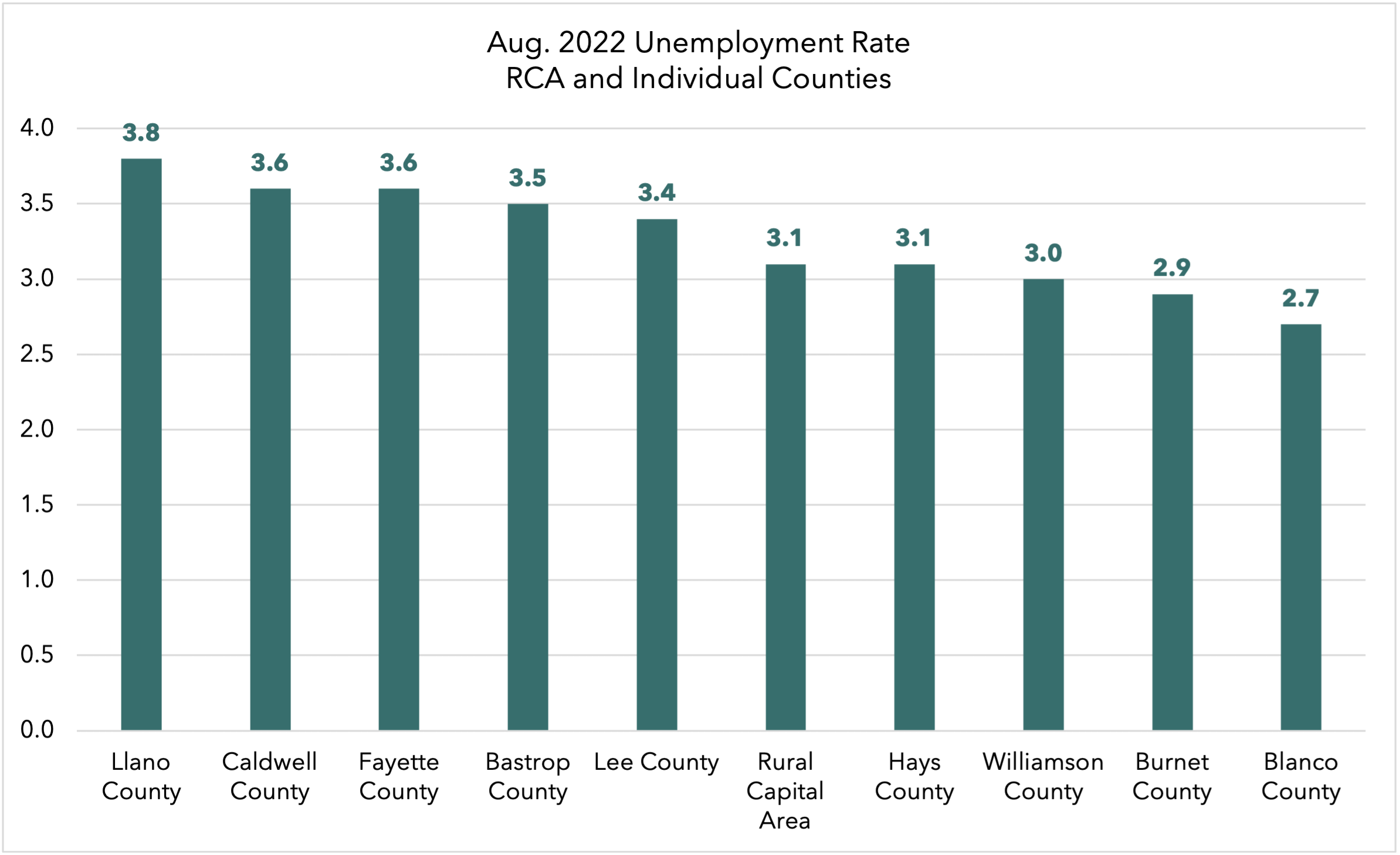The low unemployment rate across the United States is one of the oft-cited metrics explaining why inflation has been on the rise in the past year. The annual U.S. inflation rate was 8.2 percent in September, meaning prices of goods and services have increased more than eight percent since September 2021. Low unemployment contributes to inflation as employers are pushed to pay higher wages to attract workers and then pass those higher labor costs on to their customers as price increases. Supply chain issues, Russia’s war in Ukraine, and a tight labor market (economist-speak for low unemployment rates) are all factors influencing the current increase in prices.
In the Rural Capital Area (RCA), unemployment rates are just above their 2019, pre-pandemic levels, but are still low in comparison to the US and historical data. Analysis reveals that these slightly higher unemployment rates are not caused by continuous pandemic effects, but rather as a result of many people entering the labor market.
Currently, the RCA is experiencing an unemployment rate of 3.1 percent, up from a low of 2.6 percent in March and just higher than pre-pandemic values of 3.0 percent in the same month of 2019. The RCA consistently sees lower unemployment rates than the US, a positive thing when economic shocks send unemployment skyrocketing as they did in March of 2020. In today’s context, low unemployment rates may mean local employers are having a harder time finding available workers to fill roles than other places in the US. The chart below shows the unemployment rates for the RCA and US over the past five years.

By individual county Llano, Caldwell, Fayette, Bastrop, and Lee counties currently have unemployment rates higher than the regional average. Hays, Williamson, Burnet, and Blanco Counties have unemployment rates even lower than the regional 3.1 percent benchmark. See the chart below.

Comparing local unemployment rates and change in employment (two metrics discussed below) to their August 2019 values reveals a paradoxical trend. While unemployment rates are still slightly higher than pre-pandemic levels, the number of jobs in the region has increased greatly. This suggests that (for most counties) the region is past recovering jobs lost during the pandemic and higher unemployment rates are due to an increased number of individuals entering the labor force. Put another way, there is no remaining pandemic slack in the labor market. See the table below.
|
County |
Change in Unemployment Rate, Aug. 2019-2022 (percentage points) |
Change in Employment, Aug. 2019-2022 (percent) |
|
RCA |
0.1 |
10.4% |
|
Bastrop |
0.4 |
8.4% |
|
Blanco |
0.2 |
9.5% |
|
Burnet |
0.0 |
5.8% |
|
Caldwell |
0.1 |
4.7% |
|
Fayette |
0.7 |
-5.9% |
|
Hays |
0.2 |
11.8% |
|
Lee |
0.7 |
-12.8% |
|
Llano |
0.1 |
3.1% |
|
Williamson |
0.0 |
12.4% |
For example, the unemployment rate in Bastrop County is 0.4 percentage points higher than it was in August of 2019, meaning there are more unemployed individuals in the county than there were before the pandemic. However, total employment has also gone up more than eight percent in that same time frame. This suggests that it is not the same people who lost their jobs in 2020 that are still sitting on the sidelines of the economy. Instead, more people have entered the labor market to search for jobs, and the unemployment rate is slightly higher simply because there are more people in the region. Recent analysis supports this conclusion, showing that many new individuals have moved into the RCA since the pandemic began.
Only Fayette and Lee County have not fully recovered employment counts, suggesting there are still factors from the pandemic impacting the labor market in these locations.
Taken together, this all means that the RCA (as a whole) is beyond recovering pandemic-related job losses and has instead entered the same tight labor market being felt across the country.
Looking ahead, economists expect the labor market across the country to be impacted by the Federal Reserve Bank’s recent rate hikes in an effort to lessen inflation. A survey of 66 economists conducted by the Wall Street Journal found that the unemployment rate is expected to rise to 4.7 percent by the end of 2023, as the chances of the US entering a recession in the next year increase. According to the Wall Street Journal, “while a 4.7 percent unemployment rate is low by historical comparison and indicative of the current worker shortage, it suggests that the Fed’s efforts to bring down inflation will inflict some pain on workers.” Given the RCA’s historical data shown in the line graph above, local unemployment rates will likely not be as high as the rest of the US, but unemployment would certainly tick back up if the US officially enters a recession in 2023.